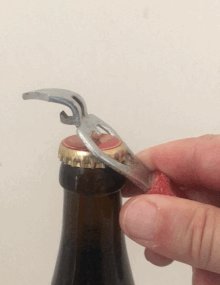bottle opener

A bottle opener is in the simplest case as a bottle opener , a tool for removing crown caps a bottle .
history
The first bottle openers came on the market with the introduction of the crown cap: the Bottle Uncapping Tool , patented by Alfred Louis Bernardin in 1893 , and the Capped Bottle Opener , patented by William Painter in 1894 . Both are quite similar in the way a bracket for the support and an edge for hooking work.
Bottle opener
There are many different bottle openers that differ not only in design , but also in lever technology. A hook or a bar is always pushed under the edge of the bottle lid, counter pressure is exerted on the lid and the crown cap is levered off. If the hook or bar is at the end of the opener, you push the handle down, if it is close to the handle, you push it up.
- Image "Using a bottle opener": A flat piece of metal has a recess inside with two parallel opposite edges; one of them lies diagonally on the crown cap, while the other reaches under the edge of the crown cap and pulls it upwards. Some small and medium-sized punches have a recess in the lever plate as a built-in bottle opener of this type.
- Image "Swiss Army Knife": A flat piece of metal with a recess on the edge serves as an economy version, one end of which presses on the lid, while the other is hooked under the edge of the crown cap. If the piece of metal is very flat and the handle is too high, it can tip over to the side or slide off.
You can remove crown caps without a bottle opener:
- With counter pressure on the glass: Use a screwdriver to turn the capsule sheet outwards in several places.
- With counter-pressure on the fingers that hold the neck of the bottle: A lighter , a ruler or a second bottle (closed with a capsule) as a lever is sufficient . Any object that can be used as a lever on the capsule is suitable.
- There are a few people who pry with their teeth.
- Or you place the edge of the fastener on the edge of a table and press or hit the edge of the fastener opposite the edge of the table with your hand. This procedure leads to gushing more often than others .
- In North America, many beer bottles have a thread between the edge of the bottle and the crown cap and can be opened with a strong twist.
Bottle openers that can do more
Two pictures show
- Above a bottle opener from Grasoli (now Carl Mertens ) made of steel, with which you can lift the capsules unbent, press them back on and press them together with the hollow cone in a gas-tight manner. Lifting off takes more force than lifting off with bending, because of less leverage;
- Below is a soda bottle opener with a swiveling head, which presses the fluted screw cap against two small metal inserts in the handle and thus prevents it from slipping, with a simple bottle opener.
The lid tongs in the next picture have four openers for bottles, namely two screw cap openers (in the symmetry axis) and two bottle openers (in the picture at the bottom), one for the usual pushing up and one for easier pushing down.
various
- Bottle openers are used as promotional items , be it by the beverage industry or by companies from outside the industry.
- They are available as gimmicks in special shapes or integrated into other devices such as lighters.
- The Shanghai World Financial Center is nicknamed "Bottle Opener".
- "Siebzehner" and "17 mm-key" (an open-end wrench with a key width of 17 mm) is particularly useful for fitters, mechanics, installers and related professions a colloquial synonym for a bottle opener. The term “17-key” is well known in large parts of the German-speaking area.
Similar tools
literature
- Mik Berger: 99 ways to open a bottle. Sonrrie Verlag, ISBN 978-3-936968-04-0
Web links
Individual evidence







